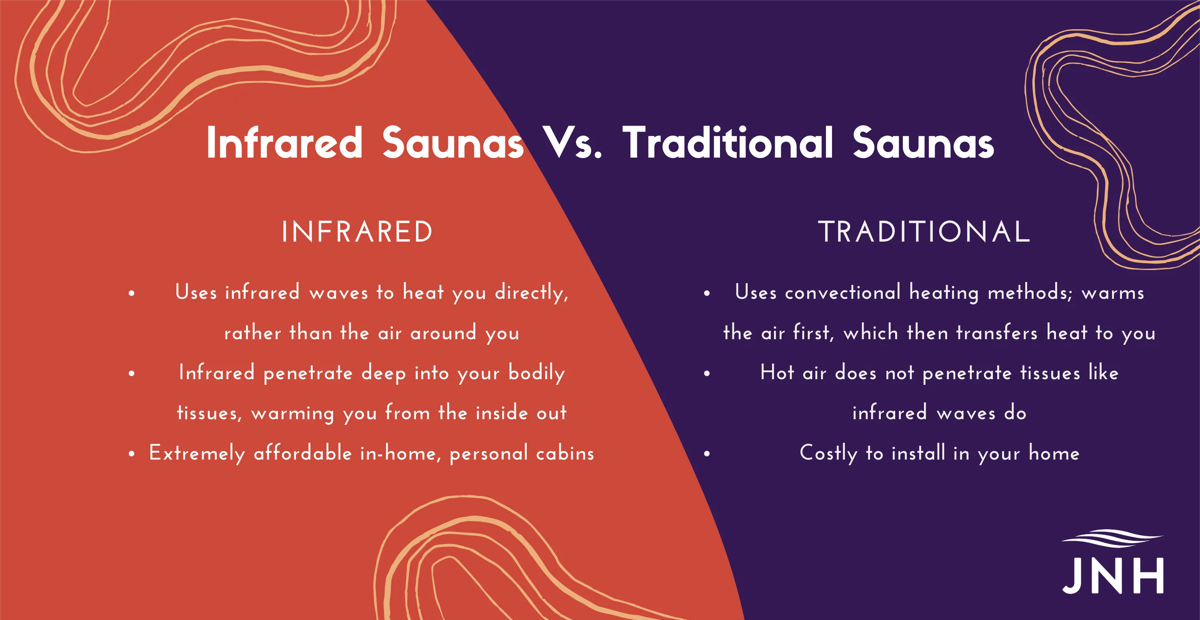Infrared Saunas
vs
Traditional Saunas
By: Your JNH Lifestylist

Are you interested in the benefits of sauna bathing? You’ve been doing your research but are probably conflicted on whether to go with the more traditional approach or trying out infrared saunas. Which is better: an infrared sauna or traditional sauna? Luckily, you’ve come to the right place. In this article, we’re breaking down the differences between the two and which you should choose.
Infrared Sauna or Traditional Sauna: Key Differences
Infrared saunas have taken off in the last few years, and they’ve begun to even replace traditional saunas. Ultimately, the main difference between these two saunas comes down to how the sauna heats up your body.
An infrared sauna is more closely related to the heat generated by the sun, which many individuals cite as a more natural remedy. These types of saunas use infrared light to heat the core of the body. The body then releases this energy as heat, and that’s where you begin to feel warm. Interestingly, you can’t see infrared waves, but you can feel it! In contrast, a traditional sauna consists of wooden walls and a fireplace or stove, which is the focal point of the generated heat. Water is also used to create steam by pouring it over a hot rock pile. The user of a traditional sauna becomes warm from the outside in because the heat is being transferred from the air to the body. As opposed to an infrared sauna where infrared waves penetrate your skin, warming the core of the body.

Traditional saunas also tend to run a lot hotter than infrared saunas. A traditional sauna runs at 185-190°F, while an infrared sauna runs at about 110-140°F.
The Pros and Cons of an Infrared Sauna
Determining which is best for you between an infrared and traditional sauna depends on what you want to get out of it, as well as your personal preferences. Interestingly infrared saunas may have more benefits than the traditional form. At the same time, they also have similar benefits.
Many studies state that thermal or heat therapy can help reduce chronic pain [1]. However, this is also alongside other treatment methods. Both traditional and infrared saunas are beneficial for weight loss as well, helping to increase your metabolism and burn more calories. More specifically, an infrared sauna works to increase your metabolism by heating up the core of the body. A traditional sauna may not have as big of an impact because of its heating methods.

An infrared sauna and traditional sauna may also both decrease stress and improve skin health. Various evidence further shows that infrared saunas may help improve cardiovascular health and help detoxify the body. A 2015 study indicated that infrared saunas may help patients with cardiovascular disease and diabetes, although researchers also stated that it should complement other therapies, such as physical therapy or improved lifestyle changes [2]. Infrared saunas have also been found to potentially help individuals with rheumatoid arthritis and ankylosing spondylitis, particularly in the short-term [3].

Photo by Autumn Goodman on Unsplash
How do infrared saunas cause these benefits? Many experts theorize that infrared saunas reduce inflammation throughout the body; and since various chronic diseases such as cardiovascular disease and rheumatoid arthritis are caused by inflammation, it makes sense as to why they’re able to help fend off the side effects of diseases like these. However, like any type of heat therapy, you want to be cautious and stay hydrated. Cons include potential dehydration if you’re not careful, as well as being dangerous for those with certain medical conditions that prohibit them from staying in heated areas for prolonged amounts of time. As such, you always want to make sure to discuss your infrared sauna use with your doctor before proceeding to ensure it's safe for you.
The Pros and Cons of a Traditional Sauna
Traditional saunas also have many health benefits - like infrared saunas. However, these benefits are much more basic, as well as more focused on relaxation. Traditional saunas may help lose weight, decrease stress, provide clearer skin, and reduce pain. Not surprisingly, traditional saunas tend to cost more to run/maintain, since they require a higher amount of energy and cleaning. So, if you’re thinking of a more economic decision, a traditional sauna might not be the best option for you.
As aforementioned, traditional saunas also don’t provide as many health benefits. For example, there’s less evidence indicating they help detoxify the body or that they reduce inflammation - like infrared saunas do. Further, as stated earlier, there may be less of a metabolic boost due to the fact that a traditional sauna does not heat the body from the inside out. An infrared sauna heats up your core, which releases heat from the skin. A traditional sauna, on the other hand, heats the air which then heats the skin. It doesn’t have the same effects.
Which Should You Choose?
So, should you try an infrared or traditional sauna? Your choice depends on your lifestyle and goals. If you want to gain more health benefits while keeping more money in your wallet, an infrared sauna is the best choice. If money is not an issue and you’re looking for a more customary experience, then a traditional sauna is right up your alley.
Here at JNH Lifestyles, we’ve made it affordable and easy for virtually anyone to add a personal infrared sauna to their home. We’re even partnered with Klarna to help you finance your sauna so you can relax now and pay later. If you have any further questions on the differences between infrared and traditional saunas, please call us at (800) 528-3110 to speak with a specialist or message us on our website/social media outlets.

Resources:
[1] Masuda A, Koga Y, Hattanmaru M, Minagoe S, Tei C. (2005). “The Effects of Repeated Thermal Therapy for Patients with Chronic Pain.” Karger, Psychother Psychosom, 18 Feb 2020, https://www.karger.com/Article/Abstract/86319.
[2] Chiang J, Shui S, Wang X. (2015). “Far-infrared therapy for cardiovascular, autoimmune, and other chronic health problems: A systematic review.” Sage Journals, 18 Feb 2020, https://journals.sagepub.com/doi/abs/10.1177/1535370215573391.
[3] Koel G, Floors M, et al. (2008) “Infrared sauna in patients with rheumatoid arthritis and ankylosing spondylitis.” Springer Link, Clinical Rheumatology, 18 Feb 2020, https://link.springer.com/article/10.1007/s10067-008-0977-y.


